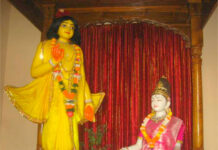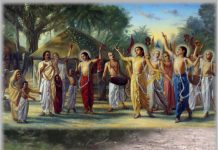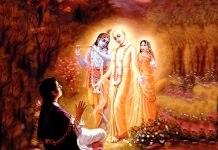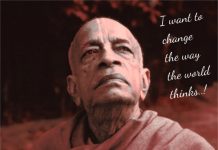As the world, frustrated over temporary material happiness, cautiously turns towards spirituality, it is sure to find a new hope in life. At the same time, in scarcity of genuine spiritual leaders, it is bound to be exposed to false propaganda by so-called spiritualists, philosophers, scholars, yogis, pseudo saints and even self-proclaimed gods. Under the circumstance it becomes vital for them to know what they read and hear as harboring misconceptions about spiritual life is the worst thing one can do to oneself.
There are number of yoga processes for achieving different types of spiritual salvation. Bhakti yoga is one such process, widely recognized to be the best one that yogis follow to attain perfection. While many concepts regarding bhakti yoga are known there are facts that are unknown to the mass. Some practitioners say that through bhakti yoga one can easily achieve love of God while others say that bhakti yoga effortlessly grants moksa or liberation from the cycle of birth and death. There are people who promote it as a devotion based on sentiments towards God, and then we have those who think that it is only the bhakti yoga by which God can be pleased. Speculations are rife on what exactly bhakti yoga is and countless books are sold in the market giving varieties of definitions.
Before we discuss the subject matter and rectify some historical errors, it is important to know what the terms “bhakti yoga” means. Already know it? Let us go through it anyway. We will keep it simple.
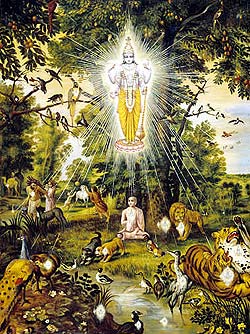
The word “yoga” is no more new to the world although most people hardly know its full potential. Sanskrit word “yoga” means to link. The word is self-explanatory; it conveys that through this process we link or connect with something or someone. According to Bhagavad Gita and other Vedic scriptures, that “something” refers to the all-pervading impersonal brahman, or the dazzling effulgence emanating from God’s transcendental body, and “someone” refers to God’s plenary expansion, Paramatma who resides in everyone’s heart, or to God Himself in His inconceivably beautiful and eternal form, Bhagavan. When an individual soul, or atma, successfully connects with any of these three, he is considered to be in trance, or samadhi. There are specific symptoms and gradations of samadhi based on the type of yoga one practices and level of perfection one achieves through it.
The word “bhakti” means devotional service. There are two main divisions of bhakti; raganuga, or spontaneous devotional service and vaidhi, or devotional service performed according to rules and regulations. While karma yoga, jnana yoga and dhyana yoga lead their practitioners to material achievements called siddhi, realization of atma or brahman and realization of paramatma or param brahman, bhakti yoga grants one with the highest form of realization – realization of Bhagavan, the personal feature of God.
So the most basic definition of bhakti yoga is, the process of connecting to God through devotional service. We will see a more comprehensive definition given by authorities later in this article.
Before proceeding, here is a quick look at what Wikipedia has to say about bhakti yoga:
“Bhakti yoga is a spiritual path or spiritual practice within Hinduism focused on the cultivation of love and devotion toward God. It has been defined as a practice of devotion toward God, solely motivated by the sincere, loving desire to please God, rather than the hope of divine reward or the fear of divine punishment.”
This is largely correct except the fact that bhakti yoga has nothing to do with the so-called Hinduism. Bhakti yoga is a science of pure relationship between living entities and God. It needs to be noted that although in present context the word Hinduism may be used in order to point at the religion followed by a particular section of people, it nonetheless does not appear in any Vedic scriptures. In fact, the world “Hindu” did not exist before several thousand years. (Reference – Is Hinduism not a religion?). One very important aspect of bhakti yoga pointed out here is, although it bestows upon the practicing yogi the highest reward, a bhakti yogi doesn’t work for it nor has he fear of any divine punishment. His only motivation is to please God.
“Bhakti yoga is often considered by Hindus to be the easiest way for ordinary people to attain a spiritually liberated state, because although it is a form of yoga, its practice is not as rigorous as most other yogic schools, and it is possible to practice bhakti yoga without needing to become a full-time yogi.” (Source wikipedia.org)
The above explanation is incomplete, inaccurate or misinterpretable.
Here is why.
- Like any other bona fide yoga system, Bhakti yoga has gradations. A sincere practitioner gradually crosses different stages starting from sraddha (pronounced sraddhaa with a long a at the end), or strong faith, to prema, or pure love of Godhead. As one progresses, his practice becomes more vigorous. The difference, however, between bhakti yoga and other forms of yoga is, a bhakti yogi works hard for the pleasure of his or her beloved Lord and so feels blissful, while other yogis work for their own purpose and so naturally find it strenuous.
- Just as any other yoga begins with a few easy steps, the beginning of bhakti yoga is also easy. In other words, just as any ordinary person can take a few first steps in any other yoga, he or she also can do the same in bhakti yoga. This does not make it “easy” as it is thought to be.
- On one hand, no yoga requires one to become a “full-time yogi” but on the other hand all yogas demand that one becomes full-time if his or her goal is to achieve the highest perfection. The same principle applies to bhakti yoga as well. However, it is true that a bhakti yogi can be staying at home but a dhyana yogi will need to stay in a solitary place where mode of goodness is visibly prominent. This is because the mode of goodness, or satva guna, helps one focus his mind on Paramatma.
- A dhyan yogi may be living in an ashram “full-time” but still having serious difficulties controlling his senses. A karma yogi may think he is doing his karma but in reality may be engaged in all sorts of vikarma, or forbidden activities, for his own sense gratification. On the contrary, a bhakti yogi may be staying at home but still be full-time engaged in serving the Supreme Lord.
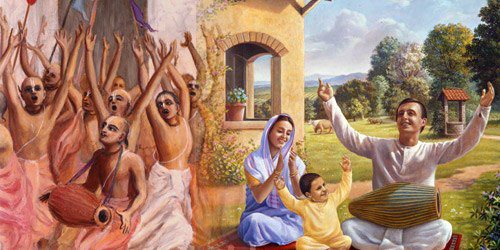
The similarities pointed out above show how spiritual life is not about externals; a lot depends on one’s consciousness while performing prescribed duties. Also, that bhakti yoga is not cheap compared to other yoga systems as some philosophers claim. Rather, later in this article we will see how it is the topmost yoga system and rewards the highest destination.
Those who say that through bhakti yoga one can achieve love of Godhead are correct but as mentioned above, it is only possible in its fully mature stage.
There are unscrupulous people called sahajiyas who present bhakti yoga as a whimsical path that can be followed in one’s own style. This is a wholesome nonsense.
There are others who dress and lecture as bhakti yogis but have abominable private life. Their underlying philosophy is, so far you do your rituals, chant prescribed number mantra and study bhakti sastra, you are all fine and can engage in any other activities, including forbidden ones. Such people exploit innocents, especially young women, or rich householders, in the name of bhakti yoga and, instead of engaging them in serving God, they engage them for pleasing their own senses or increasing their own reputation and bank balance. Such pseudo sadhus need to be exposed as a service to society.
Those who say that bhakti yoga easily gives liberation are also correct but for a bhakti yogi, liberation is not the ultimate goal as it is with the other yogis. To a bhakti yoga practitioner, liberation comes as a by-product of his devotional service. This is clearly stated in Srimad Bhagavatam (3.25.33), a natural commentary on Vedanta sutra by none other than Srila Vyasa deva himself. He says- jarayaty āśu yā kośaṁ nigīrṇam analo yathā – “Bhakti, devotional service, dissolves the subtle body of the living entity without separate effort, just as fire in the stomach digests all that we eat.”
The root cause of our existence in this world is our material desires. Once our desires are spiritualized by the process of bhakti yoga, our material existence ceases to exist and we are liberated from what is called sansara. This is mukti. A pure, unalloyed devotee rejects even mukti if that obstructs his devotional service to God. As a matter of fact, real bhakti begins after mukti because unless we are free from material contamination it is not possible to realize our eternal relationship with God.
Quoting from Narada Pancharatra, Srila Rupa Gosvami, a direct disciple of Sri Chaitanya Mahaprabhu, gives the following perfect explanation of bhakti in his book Bhakti Rasamrita Sindhu:
sarvopadhi-vinirmuktam tat-paratvena nirmalam
hrishikena hrishikesha-sevanam bhaktir uchyate

“Bhakti, or devotional service, means engaging all our senses in the service of the Lord, the Supreme Personality of Godhead, the master of all the senses. When the spirit soul renders service unto the Supreme, there are two side effects. One is freed from all material designations, and one’s senses are purified simply by being employed in the service of the Lord.” (BRS 1.1.12)
In another verse of the same book the highest form of bhakti is defined as follows:
anyabhilashita-shunyam jnana-karmady-anavritam
anukulyena krishnanushilanam bhaktir uttama
TRANSLATION: One should render transcendental loving service to the Supreme Lord Krishna favorably and without desire for material profit or gain through fruitive activities or philosophical speculation. That is called pure devotional service.” (BRS 1.1.11)
“Unfortunately, in present day society in the name of shuddha-bhakti various types of mixed devotion such as karma-misra (mixed with fruitive action), jnana-misra (mixed with speculative knowledge) and yoga-misra (mixed with various types of yoga processes) as well as various polluted and imaginary conceptions are spreading everywhere like germs of plague. People in general consider these polluted and mixed conceptions to be bhakti, respect them as such, and thus remain deprived of shuddha-bhakti. These polluted and mixed concepts are our greatest enemies.”
“Some people say that there is no value in bhakti, that God is an imaginary sentiment only, that man has merely created the image of a God in his imagination, and that bhakti is just a diseased state of consciousness which cannot benefit us in any way.” (Srila Bhaktivinod Thakur – Bhakti Tattva Viveka)
As mentioned here, there are people who either dilute the transcendental position of bhakti yoga or foolishly vilify it by saying it’s just an imagination. Such people have no idea, whatsoever, as to what bhakti yoga really is. The following are some of the reasons for their pitiable state of mind.
Those who weaken the position of pure bhakti and preach that bhakti mixed with karma or jnana can also deliver ultimate realization are weak themselves. They lack both knowledge and realization. In fact, they have failed at the first stage of bhakti, namely sraddha. Ironically, we see such people talking about the topmost stage of bhakti, which is prema, or love of Godhead. Indeed, a person pretending to be spiritually advanced is more dangerous to associate with than the one who humbly accepts his lack of realization.
Those who devalue bhakti yoga and say it’s an imagination are plain ignorant. They lack the basic understanding of spiritual science explained in Bhagavad Gita. Their lectures and write-ups are a mix of concoctions and mundane emotions. They talk on Bhagavad Gita and bhakti yoga but do not accept the authority of Lord Krishna who personally spoke it. This is the reason, as explained in Bhagavad Gita, their good intelligence is taken away by maya (mayaya apahrita jnana). Such people cannot enlighten others as they themselves live in darkness.
Some think that bhakti yoga means only chanting on beads, worshiping God and performing kirtans. They question like, “how do you spend whole day doing bhakti?” and reason like, “we cannot do it because we got to take care of family and business”. Some others say, “I like to read and meditate so bhakti yoga doesn’t suit me”. As a matter of fact, a bhakti yogi is able to perform all activities, be it at home, at factory, at university, sales, hospitals, at corporate meetings and even in courts, as good as any one else can. He could even be better as his or her focus while performing work is to please God.
In previous ages, Hanuman burnt Lanka, Arjuna killed thousands on the battlefield of Kuruksetra, and King Parikshit ruled the Earth. All were Bhakti yogis. In recent times we have seen a person like Srila Prabhupada who spent his entire life, including his householder life, practicing and preaching bhakti yoga. It is by his hard work and grace that today literally millions, most of them householders, are practicing bhakti yoga and the total number of devotees is increasing on the planet by every hour. Later in this article we will see how bhakti yoga includes all other yogas.
There is another widespread misconception that one achieves jnana platform after practicing bhakti yoga, and once that happens, one becomes detached from the world and realizes that he is one with God so there is no need to serve Him! This is another myth which, for all good reasons, stands invalid in light of Vedic scriptures.
In reality, it is the jnana, or knowledge, of the absolute truth that adds to one’s conviction that bhakti is the ultimate destination. This is unequivocally stated in Bhagavad Gita by Lord Krishna:
bahūnāṁ janmanām ante jñānavān māṁ prapadyate
vāsudevaḥ sarvam iti sa mahātmā su-durlabhaḥ
TRANSLATION: After many births and deaths, he who is actually in knowledge surrenders unto Me, knowing Me to be the cause of all causes and all that is. Such a great soul is very rare. (BG 7.19)
Bhakti yoga continues eternally as bhakti is avyayam, or imperishable. The creeper of bhakti keeps growing during one life and continues to grow in the next, and next, and finally meets its goal. The beauty of bhakti yoga is, its process and goal are the same – loving devotional service to God. In material world a bhakti yoga practitioner learns how to please the Lord and in his mature stage, he serves the Lord perfectly in the spiritual world.
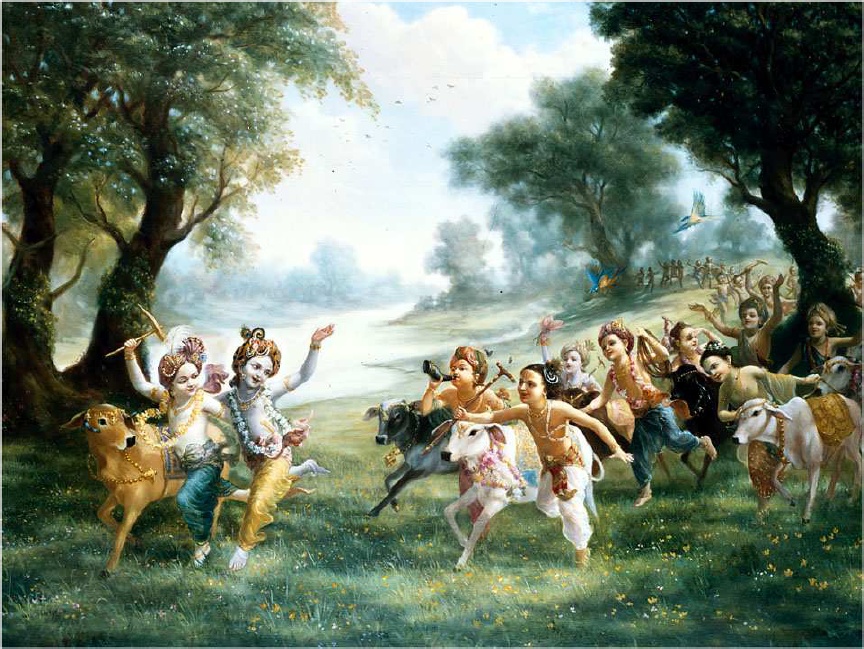
A brief analysis of yoga systems reveals how bhakti yoga is not only superior to all but also contains all other yogas in it.
- In karma yoga one has to perform his duties perfectly with full detachment. In bhakti yoga, one renders loving service to Krishna, being attached to Him. This makes bhakti yoga a pleasurable engagement.
- In jnana-yoga the process is knowledge and renunciation, but the soul being active and blissful by nature, the practitioner quite often finds it unnatural and devoid of flavor. On the contrary, a person engaged in bhakti yoga immediately comes to the platform of bliss as he selflessly engages in devotional service.
- In dhyana-yoga, one requires to mediate keeping his mind and senses under control, but the example of highly reputed sages like Visvamitra and Saubhari shows one can fall down even at an advanced stage. In contrast, emperor Ambarish, apparently a worldly man, who kept all his senses engaged in serving Lord Krishna, was able to conquer over the anger of an extremely powerful sage like Durvasa muni.
And on top of all, as mentioned earlier, a karma-yogi, jnana-yogi and dhyana-yogi gradually elevates to brahman and Paramatma realization, whereas a person engaged in bhakti yoga attains the topmost, Bhagavan realization. Srila Prabhupada often compares bhakti yoga with a lift verses ladder.
Our present situation in Kaliyuga is another, and perhaps the most vulnerable aspect that makes bhakti yoga the only practical yoga for the world today.
Performing expensive karma kanda yajnas is out of question even for today’s richest people. Besides, there is a serious lack of brahmanas who can correctly pronounce Vedic mantras. Endeavoring to realize brahman through knowledge, or jnana yoga, is also not possible as people are less intelligent and have meager memory power. This is one reason we see godless civilizations becoming prominent. Making sky-scrappers and flying spaceships is not considered real knowledge when it comes to spirituality. And dhyana yoga needs one to meditate on Paramatma for thousands of years. In previous yugas people had strikingly long lifespan but in this age it has reduced to less than 100 years. This makes it practically meaningless to perform dhyana yoga.
Knowing there will be myriads of speculations by mundane philosopher and subsequent confusion for the innocents, Lord Krishna, after enlightening Arjuna on how all yoga systems, namely karma, jnana and dhyana are auspicious, mercifully revealed to him His personal verdict on which yoga system is the topmost:
yoginām api sarveṣāṁ mad-gatenāntar-ātmanā
śraddhāvān bhajate yo māṁ sa me yukta-tamo mataḥ
TRANSLATION: And of all yogis, the one with great faith who always abides in Me, thinks of Me within himself and renders transcendental loving service to Me – he is the most intimately united with Me in yoga and is the highest of all. That is My opinion. (BG 6.47)
These are the direct words of God, or Lord Krishna, and do not need any interpretation.
We must remember that through out Bhagavad Gita, whenever Lord Krishna uses the words like “Me”, “Mine” or “My”, He is referring to Himself, that is, the very person who was standing in front of Arjuan. Some philosophers lacking realization say that such words refer to the “me” within. This is a grave misinterpretation of Bhagavad Gita verses and should be completely rejected. Lord Krishna’s transcendental body is sat-chit-ananda rupa, eternally full of knowledge and bliss.
Out of His concern for all of us, before ending His instructions to Arjuna, Lord Krishna revealed another sublime information in Bhagavad Gita (18.55):
bhaktyā mām abhijānāti yāvān yaś cāsmi tattvataḥ
tato māṁ tattvato jñātvā viśate tad-anantaram
TRANSLATION: One can understand Me as I am, as the Supreme Personality of Godhead, only by devotional service. And when one is in full consciousness of Me by such devotion, he can enter into the kingdom of God.
This kingdom of God mentioned here refers to Vaikuntha. That world, far away from the material world, is full of eternity, knowledge and bliss. There are innumerable Vaikuntha planets among which Goloka is the highest one where Lord Krishna eternally resides with His loving devotees and is eager to welcome all of us.
Deriving authority from Bhagavad Gita and other Vedic scriptures, it can be stated, without an iota of doubt, that among all yoga systems, bhakti yoga is the topmost one, and it is only bhakti yoga by which one can understand God as He is. After all, Lord Krishna Himself said it, more than once.
There are literally thousands of verses across all Vedic scriptures showing how the only yoga system that is practical in this age is bhakti yoga, which is best executed by performing sankirtan yajna, or the chanting and hearing of the holy names of God.
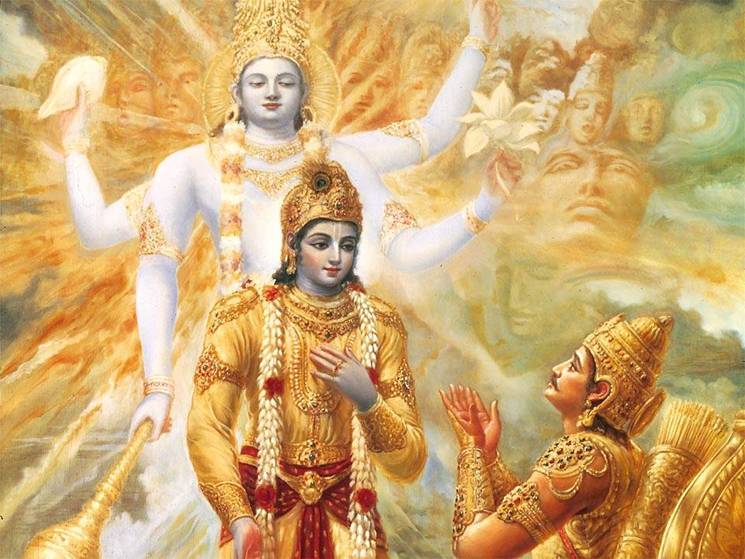
Brihad Naradiya purana (3.8.126) says:
harer nama harer nama harer namaiva kevalam
kalau nasty eva nasty eva nasty eva gatir anyatha
In this age of quarrel and hypocrisy, the only means of deliverance is the chanting of the holy name of the Lord. There is no other way. There is no other way. There is no other way.”
Sri Chaitanya Mahaprabhu, who is Lord Krishna Himself in the form of His devotee, has benevolently given a pristine process to achieve spiritual perfection, especially in Kali yuga. He advised all human beings to chant and hear the Hare Krishna maha-mantra, and blessed that just by the grace of mantra one will achieve all perfections in life.
“Everyone can accept it. Simply hear. And that hearing process is also made very easy. This chanting Hare Krishna maha-mantra you chant and hear. Anywhere you can do it. You sit down in your home or in your office, in your factory, underneath a tree or anywhere, you can chant Hare Krishna Hare Krishna Krishna Krishna Hare Hare / Hare Rama Hare Rama Rama Rama Hare Hare. And you can hear. This process will make you advanced in everything. Chaitanya Mahaprabhu has given His benediction, iha haite sarva siddhi hoibe tomara. By, simply by this chanting and hearing of Hare Krishna mantra, all perfection you’ll get. It’s very easy.” (Srila Prabhuada Lecture on S.B. 1.2.5, Aligarh, India, 9th October, 1976)
Bhakti yoga is the most easy yet the most difficult yoga. It is easy if one accepts the path shown by Lord Krishna and His unalloyed devotees, but it is most difficult for those who are envious of God. Knowing how difficult it could be for conditioned souls to understand all intricacies of bhakti yoga, Lord Krishna revealed another profound secret to Arjuna just before concluding His teachings of Bhagavad Gita:
man-manā bhava mad-bhakto mad-yājī māṁ namaskuru
mām evaiṣyasi satyaṁ te pratijāne priyo ’si me
He mercifully said: “Always think of Me, become My devotee, worship Me and offer your homage unto Me. Thus you will come to Me without fail. I promise you this because you are My very dear friend.”
Srila Prabhupada has repeatedly said that bhakti yoga is not meant only for a particular section of people. It is a science of self realization. Our faith can change, our eternal identity cannot. Bhagavad Gita helps us uncover our real identity. We have falsely identified ourselves with bodies but bodies are temporary and will vanish in due course of time, we will not. We are eternal and our constitutional position is to be engaged in loving devotional service of God, or Lord Krishna. This is the lesson and lifestyle one learns in bhakti yoga. Let the world joyfully embrace this sublime teachings and become peaceful and happy.


